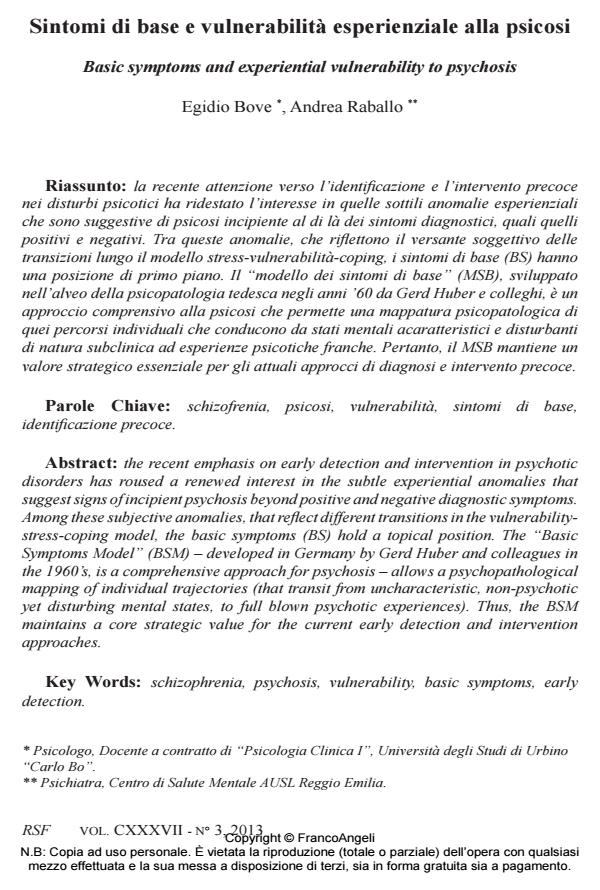Sintomi di base e vulnerabilità esperienziale alla psicosi
Journal title RIVISTA SPERIMENTALE DI FRENIATRIA
Author/s Egidio Bove, Andrea Raballo
Publishing Year 2013 Issue 2013/3
Language Italian Pages 16 P. 47-62 File size 326 KB
DOI 10.3280/RSF2013-003004
DOI is like a bar code for intellectual property: to have more infomation
click here
Below, you can see the article first page
If you want to buy this article in PDF format, you can do it, following the instructions to buy download credits

FrancoAngeli is member of Publishers International Linking Association, Inc (PILA), a not-for-profit association which run the CrossRef service enabling links to and from online scholarly content.
The recent emphasis on early detection and intervention in psychotic disorders has roused a renewed interest in the subtle experiential anomalies that suggest signs of incipient psychosis beyond positive and negative diagnostic symptoms. Among these subjective anomalies, that reflect different transitions in the vulnerabilitystress- coping model, the basic symptoms (BS) hold a topical position. The "Basic Symptoms Model" (BSM) - developed in Germany by Gerd Huber and colleagues in the 1960’s, is a comprehensive approach for psychosis - allows a psychopathological mapping of individual trajectories (that transit from uncharacteristic, non-psychotic yet disturbing mental states, to full blown psychotic experiences). Thus, the BSM maintains a core strategic value for the current early detection and intervention approaches.
Keywords: Schizophrenia, psychosis, vulnerability, basic symptoms, early detection.
- Early Intervention Services for youth at Clinical High-Risk for Psychosis: The Reggio Emilia At-Risk Mental State (ReARMS) experience Michele Poletti, in RIVISTA SPERIMENTALE DI FRENIATRIA 3/2022 pp.61
DOI: 10.3280/RSF2022-003004 - Esordi psicotici in adolescenza e giovane età adulta: prospettive teoriche e di trattamento Federica Paterlini, in RIVISTA SPERIMENTALE DI FRENIATRIA 3/2022 pp.31
DOI: 10.3280/RSF2022-003003
Egidio Bove, Andrea Raballo, Sintomi di base e vulnerabilità esperienziale alla psicosi in "RIVISTA SPERIMENTALE DI FRENIATRIA" 3/2013, pp 47-62, DOI: 10.3280/RSF2013-003004